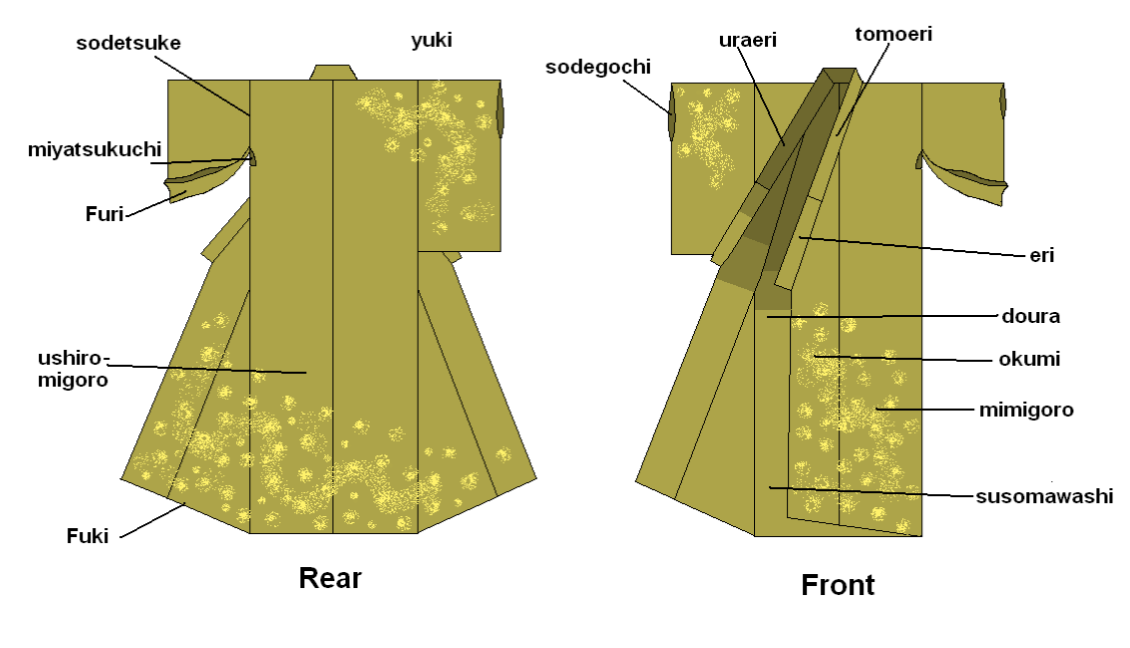45- Kimono
The kimono is a Japanese traditional garment. The word "kimono", which literally means a "thing to wear" (ki "wear" and mono "thing")has come to denote these full-length robes. The standard plural of the word kimono in English is kimonos, but the unmarked Japanese plural kimono is also sometimes used.
Kimono are T-shaped, straight-lined robes worn so that the hem falls to the ankle, with attached collars and long, wide sleeves. Kimono are wrapped around the body, always with the left side over the right (except when dressing the dead for burial)and secured by a sash called an obi, which is tied at the back. Kimono are generally worn with traditional footwear (especially zōri or geta) and split-toe socks (tabi)
Today, kimono are most often worn by women, and on special occasions. Traditionally, unmarried women wore a style of kimono called furisode,[5] with almost floor- length sleeves, on special occasions. A few older women and even fewer men still wear the kimono on a daily basis. Men wear the kimono most often at weddings, tea ceremonies, and other very special or very formal occasions. Professional sumo wrestlers are often seen in the kimono because they are required to wear traditional Japanese dress whenever appearing in public
Parts
- Dōura - upper lining on a woman's kimono.
- Eri - collar
- Fuki - hem guard.
- Sode - sleeve below the armhole.
- Obi - a belt used to tuck excess cloth away from the seeing public.
- Maemigoro - ront main panel, excluding sleeves. The covering portion of the other side of the back, maemigoro is divided into "right maemigoro" and "left maemigoro".Miyatsukuchi - pening under the sleeve.
- Okumi - front inside panel on the front edge of the left and right, excluding the sleeve of a kimono. Until the collar, down to the bottom of the dress goes, up and down part of the strip of cloth. Have sewn the front body.
- Sode - sleeve
- Sodeguchi - sleeve opening.
- Sodetsuke - kimono armhole.
- Susomawashi - lower lining.
- Tamoto - sleeve pouch.
- Tomoeri - over-collar (collar protector).
- Uraeri - inner collar.
- Ushiromigoro - back main panel, excluding sleeves, covering the back portion. They are basically sewn back- centered and consist of "right ushiromigoro" and "left ushiromigoro", but for wool fabric, the shiromigoro consists of one piece
Styles
Kimonos range from extremely formal to casual. The level of formality of women's kimono is determined mostly by the pattern of the fabric, and color. Young women's kimonos have longer sleeves, signifying that they are not married, and tend to be more elaborate than similarly formal older women's kimono. Men's kimonos are usually one basic shape and are mainly worn in subdued colors. Formality is also determined by the type and color of accessories, the fabric, and the number or absence of kamon (family crests), with five crests signifying extreme formality. Silk is the most desirable, and most formal, fabric.Kimonos made of fabrics such as cotton and polyester generally reflect a more casual style.
Women's Kimonos
- Furisode- the sleeves of furisode average between 39 and 42 inches (110 cm) in length. Furisode are the most formal kimono for unmarried women, with colorful patterns that cover the entire garment.
- Hōmongi - Characterized by patterns that flow over the shoulders, seams and sleeves
- Iromuji - single-colored kimono that may be worn by married and unmarried women. They are mainly worn to tea ceremonies. The dyed silk may be figured (rinzu, similar to jacquard), but has no differently colored patterns
- Komon - "fine pattern". Kimono with a small, repeated pattern throughout the garment. This style is more casual and may be worn around town, or dressed up with a formal obi for a restaurant. Both married and unmarried women may wear komon.
- Mofuku - is formal mourning dress for men or women. Both men and women wear kimono of plain black silk with five kamon over white undergarments and white tabi. For women, the obi and all accessories are also black. Men wear a subdued obi and black and white or black and gray striped hakama with black or white zori.
- Tomesode - single-color kimono, patterned only below the waistline.and are worn by married and unmarried women, usually close relatives of the bride and groom at weddings and a medal ceremony at the royal court.
- Tsukesage - has more modest patterns that cover a smaller area—mainly below the waist—than the more formal hōmongi. They may also be worn by married women.The differences from homongi is the size of the pattern, seam connection, and not same clothes at inside and outside at "hakke." As demitoilet, not used in important occasion, but light patterned homongi is more highly rated than classic patterned tsukesage. General tsukesage is often used for parties, not ceremonies.
- Uchikake - is a highly formal kimono worn only by a bride or at a stage performance. The Uchikake is often heavily brocaded and is supposed to be worn outside the actual kimono and obi, as a sort of coat. One therefore never ties the obi around the uchikake. It is supposed to trail along the floor, this is also why it is heavily padded along the hem. The uchikake of the bridal costume is either white or very colorful often with red as the base colour.
- Susohiki / Hikizuri - is usually worn by geisha or by stage performers of the traditional Japanese dance. It is quite long, compared to regular kimono, because the skirt is supposed to trail along the floor.
disclaimer: al the images in this page are taken from google image searc, the credits for the images are to the original owners of the image only.







EmoticonEmoticon